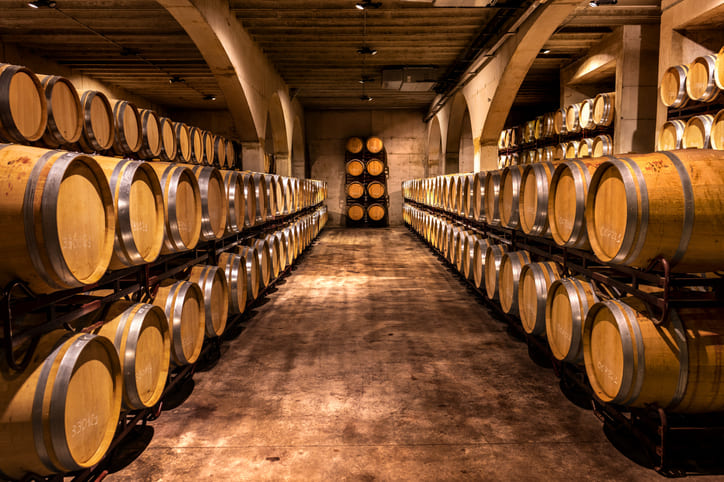ISO Tank Container: Efficient Bulk Liquid Transport
Table of contents
An ISO tank container is a reusable, insulated steel container that is used to transport hazardous liquids, such as spirits, in bulk. They can also carry other liquids, including wine and beer. Often simply called an ISO tank, ISOtank or ISO tankers, ISO tanks are a cylinder-shaped tank that is fixed inside a 20 ft (ca. 6 m) frame.
Commercial production began in 1966, followed by standardization to the form you see today in the early 1970s. ISO tank containers are credited with being one of the most significant innovations of modern shipping. Their standard size and shape has streamlined the process of loading and unloading ships, reducing the cost of shipping.
Today, ISO tanks are used to transport products such as beverages quickly and safely to their destination. So, if you’re looking to transport wine, beer, spirits or other beverages from A to B in perfect condition, then an ISO tank container is one solution.
What does ISO stand for?
If you’re wondering what an ISO tank container is used for, you’ll probably also want to know what ISO means.
ISO stands for the International Organization for Standardization (ISO). ISO tank containers are designed for international intermodal transport, made to the standards set by the ISO.
Why are ISO tanks used for shipping spirits?
Understanding how to ship your beverages correctly is important, especially for spirits, which are classed as hazardous substances and must be transported either in bottles or in bulk in an ISO tank container. ISO tanks are a cost-effective, reliable and safe way of transporting spirits in bulk. Food-grade ISO tank containers transport your spirits and other beverages like wine and beer in an environment that preserves their quality.
What types of ISO tank containers are there?
ISO tank containers are often designed to carry a specific product. This means there are a wide range of capacities and features available depending on their intended function. Spirits are carried by T11 ISO tank containers, which are built to carry non-hazardous light liquids. Hillebrand Gori’s fleet of ISO tank containers are T11.
The ‘T’ code system is used to classify ISO tank containers based on their uses, including:
- T1 ISO tank container: built to carry wine and light liquids.
- T4 ISO tank container: for carrying non-hazardous edible and non-edible oils
- T14 ISO tank container: for transporting hazardous chemicals and acids.
- Rubber-lined ISO tank container: designed to transport certain chemicals safely.
What is an ISO tank container made of?
ISO tank containers are made of stainless steel to transport your spirits or other beverages in optimal conditions. The standard 20 ft (ca. 6m) frame is made of mild steel, which is welded to the tank itself. Our ISO tanks come in a range of sizes, from 25,000 L to 26,000 L, or 24,000 L under contract.
Benefits of using an ISO tank container
ISO tank containers are designed to deliver their loads in perfect condition. You can use ISO tanks to move any alcohol safely and in optimal conditions. ISO containers are intermodal: able to be carried by road, rail, truck and ship, making transporting your products simpler and quicker. At Hillebrand Gori we offer ISO tanks that are:
- Food grade
- Insulated, to protect from temperature changes
- Approved for carriage of IMDG Class cargoes
- Enhanced with added inbuilt protection for high value products
- Suitable for medium to long term storage
- Traceable, with our track and trace system that records the fleet’s product history and matches shipments to ISO tanks
- Clean and hygienic, with our cleaning operations present at over 100 depots worldwide
- Accredited, to ISO 14001
What is the global availability of ISO tank containers?
The availability of containers has been at the center of the shipping challenge felt globally in recent years. Although congestion is easing across North America and Asia, container availability is still limited in some locations as the industry recovers from the effects of the COVID-19 pandemic.
There are steps distilled spirit suppliers can take to mitigate the impact of the global container shortage, such as shipping beverages in larger volumes less often, and booking as early as possible. We can help you navigate the shortage and find the best solution for your needs. You can read our update on the global container shortage in our article from November 2022.
Find out more about alcoholic beverage logistics with a specialist freight forwarder
Hillebrand Gori has over 50 years’ experience in providing specialist ISO tank containers that ensure spirits and other alcoholic beverages reach their destination quickly and in perfect condition. With the world's largest dedicated food-grade fleet, when you work with us, you'll be working with a team of logistics experts with a true passion for wine, beer, and spirits.
Find out more about why we're trusted by major BWS producers by contacting us to discuss how we can meet your shipping needs.
Published 16th February 2023, updated 25th October 2023
Using ISO tank containers for alcohol transportation has multiple environmental benefits. Our containers are reusable, reducing waste and minimizing the carbon footprint of each shipment.
You should consider the size and type of container needed and that the loading and discharge procedure is compatible with your point of origin and destination. You should also ensure that the container meets all necessary safety standards and regulations for transporting alcohol. Our team at Hillebrand can provide guidance on choosing the right container.
Regulations that apply to ISO tanks include the International Maritime Dangerous Goods (IMDG) Code, Accord Dangereux Routier (ADR) and the UN/DOT regulations for hazardous materials.
After each use, a certified cleaning terminal will clean and inspect the container. They'll ensure it meets all necessary cleanliness levels and is free of damage before it’s used again.





